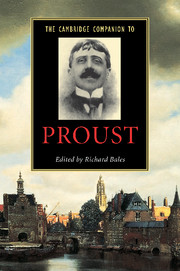Book contents
- Frontmatter
- Introduction
- 1 From Belle Epoque to First World War
- 2 The vast structure of recollection
- 3 Ruskin and the cathedral of lost souls
- 4 The birth and development of A la recherche du temps perdu
- 5 Lost and found: the structure of Proust’s novel
- 6 Proust’s Narrator
- 7 The unconscious
- 8 The texture of Proust’s novel
- 9 Proust’s human comedy
- 10 Proust and social spaces
- 11 Love, sexuality and friendship
- 12 Proust and the fine arts
- 13 Proust and posterity
- Postlude
- Select bibliography
- Index
6 - Proust’s Narrator
Published online by Cambridge University Press: 28 May 2006
- Frontmatter
- Introduction
- 1 From Belle Epoque to First World War
- 2 The vast structure of recollection
- 3 Ruskin and the cathedral of lost souls
- 4 The birth and development of A la recherche du temps perdu
- 5 Lost and found: the structure of Proust’s novel
- 6 Proust’s Narrator
- 7 The unconscious
- 8 The texture of Proust’s novel
- 9 Proust’s human comedy
- 10 Proust and social spaces
- 11 Love, sexuality and friendship
- 12 Proust and the fine arts
- 13 Proust and posterity
- Postlude
- Select bibliography
- Index
Summary
Men who produce works of genius are not those who live in the most delicate atmosphere, but those who have had the power . . . to make use of their personality as a mirror, in such a way that their life, however unimportant it may be, is reflected by it, genius consisting in the reflective power of the writer and not in the intrinsic quality of the scene reflected.
A l’ombre des jeunes filles en fleursProust's Narrator is the successor to a long line of heroes in European fiction who mirror the author's sensibility and reflect his conception of reality. This mirror is different however. The central character in A la recherche du temps perdu is more akin to Flaubert's and Stendhal's characters who reflect their inner vision of the world outside them, than to the robust actors of La Comédie humaine whose physical image is inseparable from the reality they represent. The psychological analysis of Proust's fictional hero reaches into the cocoon of sensations, impressions and reflections which inform his view of himself as an artist. It is they which furnish the key to the Narrator's personality. If we wish to understand him we must look into his mirror, share the images swirling around in his imagination and unravel the process by which they form patterns which will turn into a work of artistic creation. The path down which the reader is led is the same as that which the central character himself follows without realising it. The originality of the portrait lies in the fact that the novelist he becomes at the end of A la recherche du temps perdu relives his transformation and shares it with the reader without damaging the chrysalis from which he is emerging.
- Type
- Chapter
- Information
- The Cambridge Companion to Proust , pp. 85 - 99Publisher: Cambridge University PressPrint publication year: 2001



